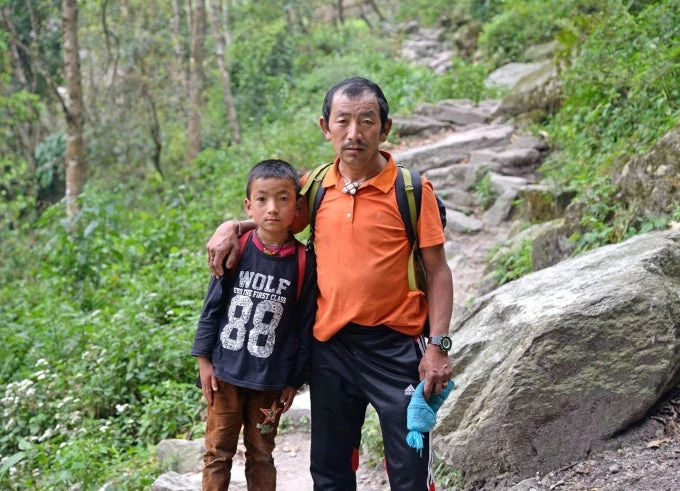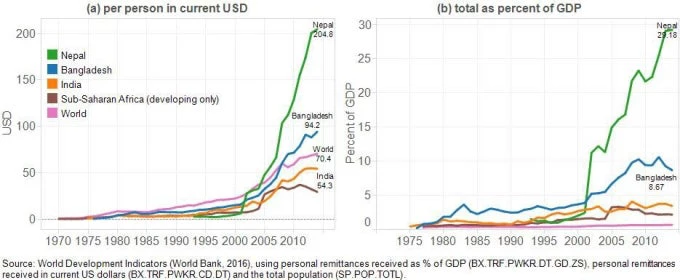

The year 2015 was rough on Nepal. The catastrophic earthquakes that struck the country in April/May caused widespread destruction of life and property and was followed by disruptions in the south that brought cross-border trade with India to a complete standstill for 4 months. As dramatic as these recent shocks have been, Nepal is no stranger to conflict and fragility. A 10-year violent Maoist conflict ended in 2006 but the ensuing years of drafting a new constitution were turbulent; politics often dominating the discourse as opposed to economics. But despite these unfavorable odds, Nepal made rather surprising progress on improving living standards and reducing poverty.
Between 1995 and 2010, absolute poverty – measured as the proportion of people living below the national poverty line of Rs.19,261 per person per year – declined steadily by around 2.2 percentage points a year. This helped the country meet the MDG target of halving income poverty by 2015 quite comfortably. Living standards improvements were realized not just based on income or consumption but also along multidimensional measures of well-being that take into account access to essential services such as education, health and drinking water and sanitation. What was behind this progress on poverty reduction Nepal achieved amidst a violent conflict and a tumultuous post-conflict recovery?
The analytical work we carried out points to three main drivers: migration and remittances, labor income and demographics.
Overseas work opportunities and remittances
Overseas migration has increased in Nepal quite dramatically in the last two decades. Between 1981 and 2001, only about 3 percent of the population was abroad. By 2011, over 7 percent of the population was abroad. Roughly a fourth of all Nepali households have a migrant abroad. The increase in international migration is mostly driven by the increase in migration to destinations other than India, which registered a six-fold jump from 2001 and 2011, particularly in the Persian Gulf and Malaysia.
This growth has been accompanied by unprecedented growth in remittances sent home by migrant workers. Until the late 1990’s, personal remittances received was less than one percent of GDP. This increased steadily to stand at 29 percent in 2014. Households with overseas workers have benefited from remittances sent by family members working abroad and seen their incomes and living standards rise.

Labor income and opportunities at home
But migration and remittances have also created opportunities for those that remain at home. For example, outflow of predominantly working age males from rural areas has caused farm wages to go up, directly benefitting wage workers in agriculture, who are often the poorest demographic group in Nepal. Likewise, remittance induced increase in incomes have also caused a surge in the demand for non-farm goods and services (e.g., restaurant meals, readymade garments) leading to the diversification of the rural economy. Off-farm activities have increased, generating employment opportunities – including in self-employment – and boosting income from wages for those engaged in it.
A micro-decomposition analysis we carried out shows that labor income contributed to more than half of the overall poverty reduction observed between 1995 and 2010, much more than the share accounted directly by private receipts of remittances (27 percent). Likewise, non-agricultural incomes played a significantly larger role in poverty reduction than agricultural income confirming the importance of opportunities created by the growth in non-farm activities.
Demographic tailwinds
High population growth was long regarded as one of the major challenges to poverty reduction in Nepal. The country’s population had almost doubled between 1960 and 1990 and was projected to double again between 1990 and 2015. However, starting in the early 1990s, Nepal’s population growth started slowing down. This was driven by a sharp decline in fertility rates: the number of births of an average Nepali woman declined from 6 in the 1970s to around 2 in 2014. The expansion of mass education, expansion of economic opportunities in the urban areas, growth in the rates of female labor force participation, delayed marriages are some factors that could have contributed to this trend.
As a result, Nepali households are, on average, much smaller today. The fraction of household members who need to be supported (elderly, infirm and children) relative to those who are of working age and can participate in economic activities has continued to decline over the years. This has enabled households to maintain living standards they may not otherwise have been able to enjoy.
Considering where Nepal started two decades ago, the progress the country has achieved in reducing poverty is quite remarkable. The fact that it was achieved despite a less than ideal political and macroeconomic environment makes this progress even more striking. Yet, building on this success to sustain continuous improvements in the wellbeing of the less well-off in the future will continue to pose significant challenges.
Previous blog: http://blogs.worldbank.org/endpovertyinsouthasia/striving-struggling-and-thriving-nepal
Working paper: Moving Up the Ladder : Poverty Reduction and Social Mobility in Nepal



Join the Conversation